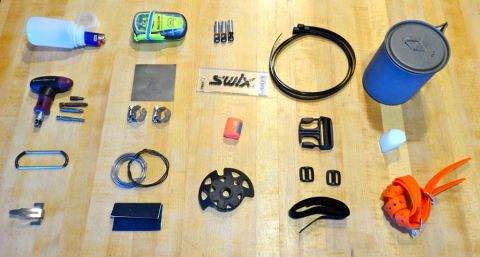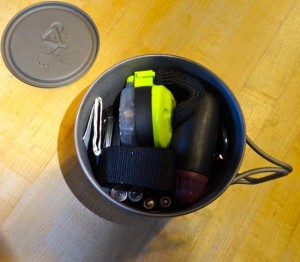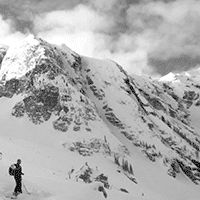What is In Your Backcountry Ski Repair Kit?
One thing that is often over looked by most backcountry skiers is their repair kit. If they even carry one at all it likely has too little in it. Have a read over this comprehensive list from the folks at amountainjourney.com:

Things can go wrong in the backcountry pretty quickly making a simple ski tour turn into an epic mountain nightmare. If you’ve ever blown out a heel piece, busted a buckle, or snapped a pole in the middle of the backcountry, you know the value of a backcountry ski repair kit.
Before the backcountry ski season really ramps up, take a bit of time and get your backcountry ski repair kit ready to go. A backcountry ski repair kit isn’t something you ever want to use, but you’ll thank you’re lucky powder turns that you have it when you need it.
There’s no perfect backcountry ski repair kit. Instead a it’s a mishmash of odds and ends that can get you out of a potentially miserable situation. It’s up to you to carry what you think you might need based on where you are going, how long you’ll be gone, what you’re going to ski, what type of gear you’re using, and who’s going with you. It might surprise you how few people actually are prepared for an emergency gear failure, so build your kit strong enough to help a friend in need.

Here’s my basic backcountry ski repair kit that goes out with me every day:
- Lighter – You never know when you’ll need to start a fire. I usually carry mine in a small Nalgene container to ensure that it stays dry and functional.
- Binding Buddy – Screws come loose at the most inconvenient times. Bring a handful of useful sizes screws. Bring a 2″ T20 driver for Dynafit bindings. This thing saved my butt on Mt. Baker’s Coleman Glacier.
- Skin Tip Attachment – These don’t break very often, but when they do, you’re S.O.L. If you’re skin won’t stay on, good luck.
- Skin Tail Attachment – It’s easy to lose these and they are surprisingly hard to duplicate.
- ACR ResQLink Personal Locator Beacon – I hope I never have to use this. If I’m faced with a grave and imminent situation, all I have to is push the button and Search and Rescue will be alerted to my exact position via satellite. There’s no fees involved with a PLB and it works anywhere in the world as long as it’s above -40. Other emergency communication devices include sat phones, Spot, or Delorme inReach. These options allow communication via voice or text message, but are more costly.
- Pole Splint – A small piece of flexible aluminum and two hose clamps can put a snapped pole back in working order.
- Bailing Wire – Small gauge wire can be twisted, looped, and hooked to fix all sorts of problems.
- Clothing Patch – This adhesive ripstop can patch any tear in a jacket or tent.
- AAA Batteries – Both my Black Diamond ReVolt Headlamp and my Barryvox Pulse Beacon use AAA batteries. I always check them, but have extra batteries just in case. Can you imagine being in avalanche terrain without a beacon? They always come in handy at the trailhead for that forgetful friend.
- Plastic Scraper – Used as a maintenance tool to scrape skis of ice and/or glop. You can also use a crystal card for this.
High Vis Tape – Whiteout conditions can hit unexpectedly. A bit of high vis can help you find your way back and keep you from getting helplessly lost.
- Pole Basket – A proper basket is hard to replicate. If you don’t have one, it’s almost impossible to move across powder plains. Make sure it fits your pole.
- Zip Ties – A variety of zip ties is super helpful. I’ve used them on buckles and zippers. Be creative with these beefy monsters and you’ll be able to fix just about anything.
- Buckle – I usually carry a full waist buckle. It’s hard to travel through the mountains with a full pack’s weight only on your shoulders.
- Nylon Webbing with Tri-Glides – I haven’t ever used this, but it seems like it will be useful to fix something eventually.
- Stoic 700ml Titanium Pot – If you’re going to get stuck out overnight, you better have a way to melt snow for water. This doubles as the container that holds the majority of backcountry ski repair kit. Find a small pot that holds your kit.
- Wax – When the snow gets sticky, rub wax on those ski bases and skins.
- Voile Straps – These are possibly the most versatile tool you’ll carry. Strap your skis and poles in a tight package. Build a rescue sled. Splint an arm. Fix a floppy skin. Cut off a chunk as a firestarter if you’re stuck for a while – they burn great. Carry at least 2. The 24″ and 18″ are the best. Be sure to get ones with metal clips, not plastic.
Everything in the above list (except the plastic scraper and Voile straps) fits inside the Titanium pot. All of these things have a combined weight of 1 lb 5 oz. Yes, that’s a bit of weight, but when you need one of these things, there’s really no alternative. This repair kit has certainly saved my butt more than once.







